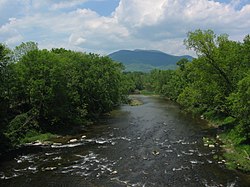| Windsor Upper Dam | |
|---|---|
 Windsor Upper Dam | |
 | |
| Location | Windsor, Vermont |
| Coordinates | 43°28′36″N72°23′46″W / 43.47667°N 72.39611°W |
| Construction began | June 1834 |
| Opening date | November 1834 |
| Operator | Ascutney Mill Dam Company |
| Dam and spillways | |
| Impounds | Mill Brook |
| Height | 40 ft (12 m) |
| Length | 250 ft (76 m) |
| Width (base) | 36 ft (11 m) |
Ascutney Mill Dam Historic District | |
| Location | 55 and 57 Ascutney St., Windsor, Vermont |
| Area | 4.8 acres (1.9 ha) |
| Built | 1783 |
| Architect | Simeon Cobb |
| Architectural style | Federal-Greek Revival |
| NRHP reference No. | 06001236 [1] |
| Added to NRHP | January 9, 2007 |
Ascutney Mill Dam, also known as the Windsor Upper Dam and the Mill Pond Dam, is an arch-gravity dam which is one of the oldest and among the earliest storage dams in the United States. It is made of cut granite and is located in Windsor, Vermont in Windsor County near the Connecticut River, where it functioned as a source of hydropower and, later, hydroelectric power. It is on the ASCE list of historic civil engineering landmarks since 1970 [2] and is listed on the National Register of Historic Places (as Ascutney Mill Dam Historic District) since January 09, 2007. [1]
Contents
- Background
- History and planning
- Construction
- Condition
- Topographic information
- Nearby areas
- Fishing
- Footnotes
- Further reading
- External links
The dam is built in the valley of the Mill Brook, a right tributary of the Connecticut River. The pond above the dam is known as the Mill Pond.
The Ascutney Mill Dam Company was formed to build the dam. Construction began in June 1834, and was finished in November. The purpose of the dam was to regulate seasonal water flow and provide hydropower for nearby sawmills and gristmills, which previously could not operate during periods of low water flow in Mill Brook. The dam allowed water to be stored in the impound during the winter for release during lower flow seasons. [3]
Ithamar A. Beard was a New England engineer who surveyed the area and selected the site for the dam. Simeon Cobb and Joseph Mason were the contractors in charge of building the dam. [3] [4]





